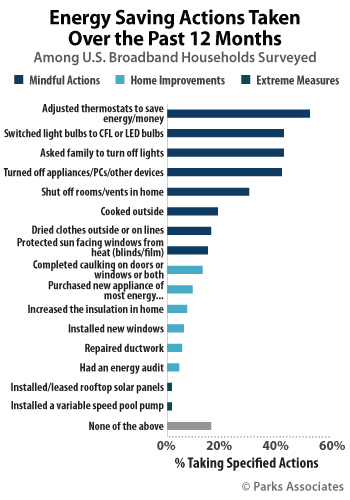How Far Will Consumers Go with Energy-Saving Activities?
 Imagine a hot summer night in Phoenix, one of the hottest major cities in the United States. I’m visiting my grandmother’s home while on a break from college and sleeping on the pullout couch in her guest room. It’s 2 a.m., and I have awoken feeling quite warm and am unable to return to a peaceful slumber. That’s because my grandma has turned up the thermostat to 82 degrees. Her formative years were during the height of the Great Depression, and throughout the course of her life, she was always going out of her way to save money. Do I dare turn down the thermostat and incur some wrath during daylight hours so that I can sleep?
Imagine a hot summer night in Phoenix, one of the hottest major cities in the United States. I’m visiting my grandmother’s home while on a break from college and sleeping on the pullout couch in her guest room. It’s 2 a.m., and I have awoken feeling quite warm and am unable to return to a peaceful slumber. That’s because my grandma has turned up the thermostat to 82 degrees. Her formative years were during the height of the Great Depression, and throughout the course of her life, she was always going out of her way to save money. Do I dare turn down the thermostat and incur some wrath during daylight hours so that I can sleep?
This entertaining and admittedly extreme example illustrates a key data point from Parks Associates’ smart energy research. Adjusting a thermostat is the most common energy-saving activity. Other common energy-saving activities include switching home light bulbs to CFL or LED bulbs, turning off lights when a room is not in use, and turning off electronics when not in use. These actions represent some of the easiest ways that consumers can save energy and money.
As an energy-saving action gets more costly and possibly time consuming, data points indicate that fewer consumers will take that action. Examples of less common energy-saving actions include purchasing a new, energy efficient model to replace a less energy efficient model, increasing home insulation, repairing ductwork, and installing rooftop solar panels.
For many U.S. consumers, memories of the recent recession that was the worst since the Great Depression are still reasonably fresh. Collectively, consumers did experience financial pain during the late 2000s/early 2010s, and many are still even dealing with the financial impact of those years. As economic conditions have improved in recent years and the technology of the smart home has diffused into a broader audience, the idea of making purchases that will induce greater savings in the longer term will serve as a greater purchase motivator than it has for earlier adopters.
Finally, to answer the question above, I did turn down the thermostat to something slightly more reasonable to fall asleep. I valued a good night sleep more than a few degrees on the thermostat, and even as a head-of-household, independent adult now, I still feel the same way. However, like many consumers we study, I will adjust a thermostat when I’m not home to save money.
Further Reading:
- Offering $100 rebate more than doubles purchase intentions for smart thermostats
- The Impact of IoT on the Utility Business Model
- Smart Home-Utility Partnership Opportunities
Next: People Power: Making the connection between provider and consumer
Previous: 2017 Smart Energy Summit contest winners announced
Comments
-
Be the first to leave a comment.
Post a Comment
Have a comment? Login or create an account to start a discussion.


